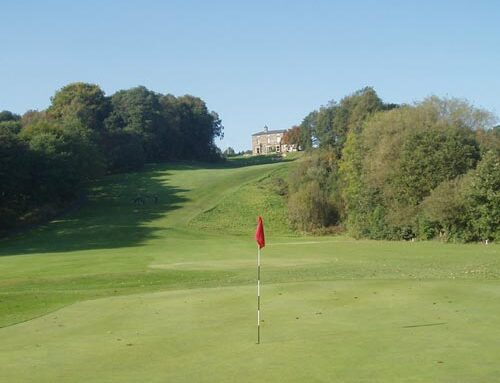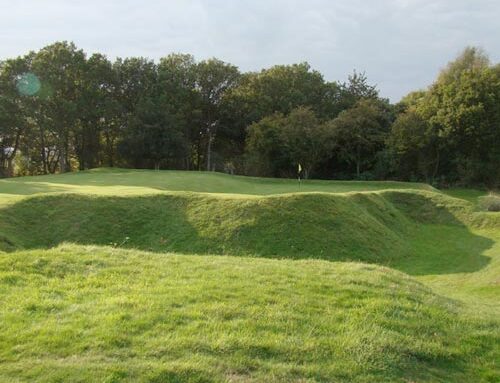Royal St. George’s Golf Club
England
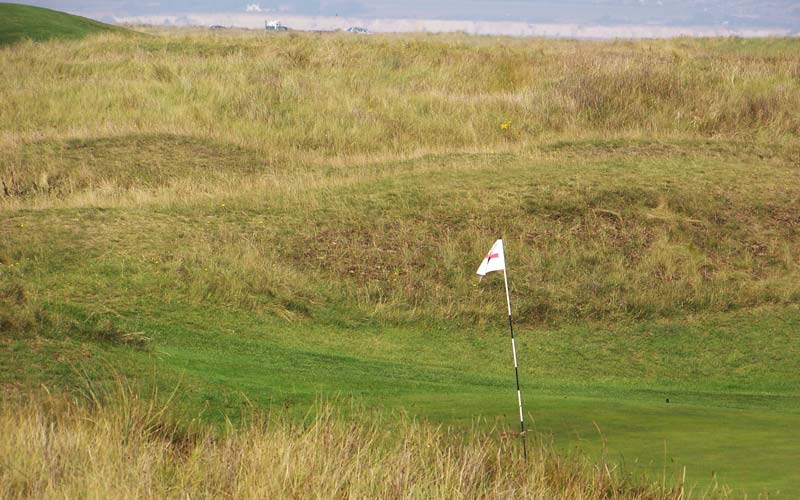
Set along the English Channel, a game at Royal St. George’s has always been about man battling nature in an epic dune setting.
Royal St. George‘s tends to polarise opinions. Several noted professional golfers including Jack Nicklaus cite it as their least favorite Open course while several of the game’s great chroniclers including Bernard Darwin place it on their short list of very favorites. How can there be such disparity?
The answer lies in one’s personal definition for the characteristics that define greatness. If you are Jack Nicklaus, you might argue for the merits of Muirfield over Royal St. George‘s as you believe that hazards should be seen so that playing strategies can be developed accordingly. If you are Bernard Darwin, perfect optics strike you as a bit mundane, a bit too matter of fact for the nuanced game of golf. Without the occasional bad bounce or blind shot, is the game nearly as fun?
To the author’s mind, Royal St. George‘s embodies the best of both worlds: big clean hitting is required across this expansive links while at the same time it retains a charm and quirk unlike all the other Open rota courses save for The Old Course at St. Andrews.
Royal St. George‘s has hosted the Open Championship thirteen times, in 1894, 1899, 1904, 1911, 1922, 1928, 1934, 1938, 1949, 1981, 1985, 1993 (!), and 2003. It is scheduled to host the 2011 Championship as well. As its holes have been markedly changed in order to continue to host golf’s most important event, Royal St. George‘s makes for a fascinating study in the development of golf course architecture for over a century. Understanding when, what and who drove certain changes to this historic links traces the evolution of the game as well. For instance, the shift from gutta-percha to the rubber core Haskell brought alterations to the course prior to hosting the 1911 Open. As golf course architecture became more defined during its Golden Age, the desire to balance the length of the two nines drove further changes. After World War II, blind shots became out of vogue and thus, the course fell from favor until modifications were made in the mid-1970s. Yet, throughout all its variations, Royal St. George‘s has remained true to its founder’s vision of being an epic test in one of the game’s great secluded settings, as we see below.
Holes to Note
First hole, 440 yards; Pat Ward-Thomas selected this as his ideal opening hole in the 1976 edition of The World Atlas of Golf. In particular, he wrote, ‘The paramount requirements for an opening hole is that it should enable play to flow from the outset… It should also whet the golfer’s appetite for the test ahead, a mission more easily accomplished should its prospect be instantly appealing.’The rumpled fairway lets the golfer know that this is real links golf, with allowances needing to be made for the stance and wind all round long. Interestingly enough, the bunkering scheme on the first is different to the initial one devised by Laidlaw Purves. Originally, he had one large bunker guarding the high left side of the green. Today, one finds a string of three bunkers cut into that same ridge just prior to the green, with the bunkers extending more across the front of the green than previously. Also, a bunker was later added seventy-five yards from the green in the middle of the fairway. Given that Laidlaw Purves was a huge fan of cross hazards, as articulated in his 1911 paper A Defence of Cross Hazards as a Test of the Game,no doubt he would approve.
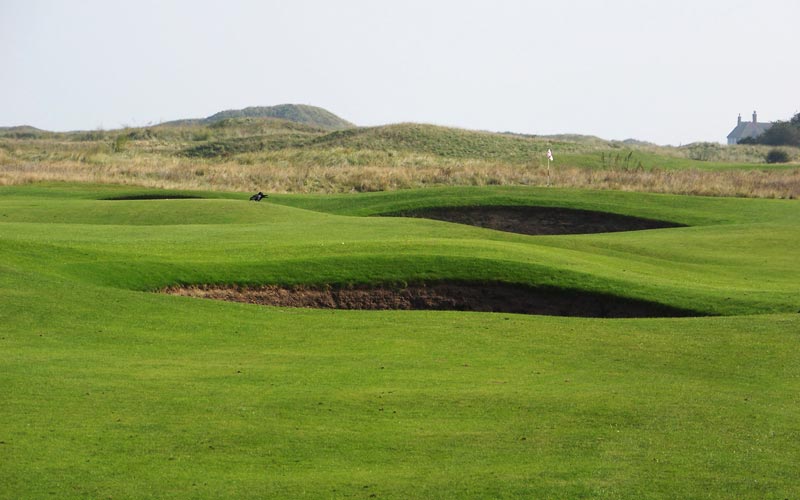
The approach to the first is over bunkers to a green that runs away. After 120 years since Purves initially laid out the course, Royal St. George’s still reflects his desire to place hazards where they matter the most – directly in the line of play.
Second hole, 415 yards; Royal St. George‘s has the ability to continue to host Open Championships in part because it has the luxury of space. Thus, its holes can grow in length and keep pace with the modern game. Here at the second is a fine example.When Laidlaw Purves laid it out in the days of hickories and gutta-percha balls, the hole measured just over 300 yards, calling for a drive and niblick.When steel shafts took over the game, the tee was moved to the right and back, bringing the hole to 375 yards. Then for the 2003 Championship, the same playing angles were preserved but the tee was stretched back another forty yards. Despite nearly 120 years of play to the same green site, golfers are still likely to play a driver/nine iron to this hole.

Assisted by Green Keeper Ramsey Hunter, Purves leveled off the top of a dune in 1887 to create today’s second green. Its natural defenses have stood the test of time and include a false front that sends balls into the waiting front right bunker.
Third hole, 210 yards; Bernard Darwin dearly loved the old third, an unconventional hole in the 280 yard range that called for a blind shot toward a green tucked down in the dunes. After Bobby Locke’s Open win in1949, the hole sadly fell from favor, owing to its blind nature and its element of chance. Traditionalists such as Darwin never wavered in their support but the ‘new purists’ sniffed at its blindness. Because of this hole and a couple of other quirks, no invitation was forthcoming from the Royal & Ancient to host the Open again. By the early 1970s, eager to change that, the club brought in Frank Pennink. He made three significant changes to the course, with the first here and the other two at the eighth and eleventh as we see later.
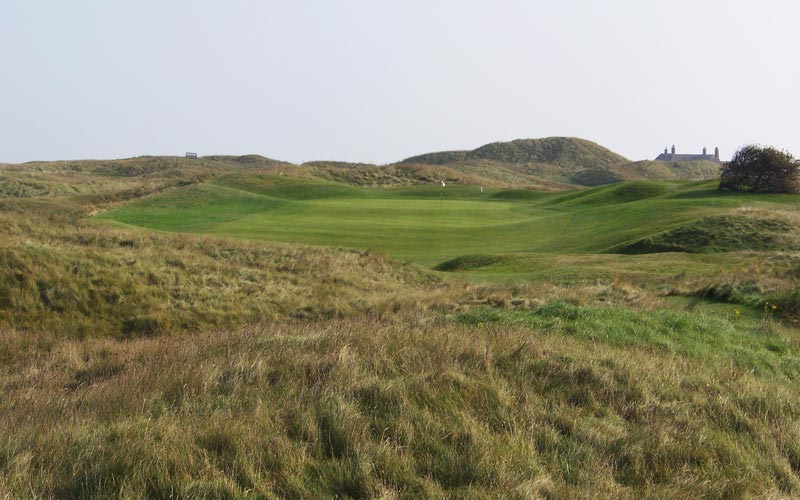
A view from Pennink’s third tee shows an attractively conventional par three hole with its green nestled into the dunes.
Fourth hole, 495 yards; The ideal tee shot is over the second deepest bunker in England, behind only the sixth fairway bunker at St. Enodoc. However, the carry must be negotiated here with the driver as opposed to a shortish iron at St. Enodoc. Once accomplished, the approach shot is actually the harder of the two shots as it ascends to a heavily contoured green high on a dune. Many a double bogey and worse was scored here in the 1985 Open when it averaged 4.66 for the world’s best. The Royal & Ancient called it a par five for the 2003 Open, only so they wouldn’t have to listen to the professionals whine. For scale and for sheer exuberance, no hole on the current Open rota matches it.
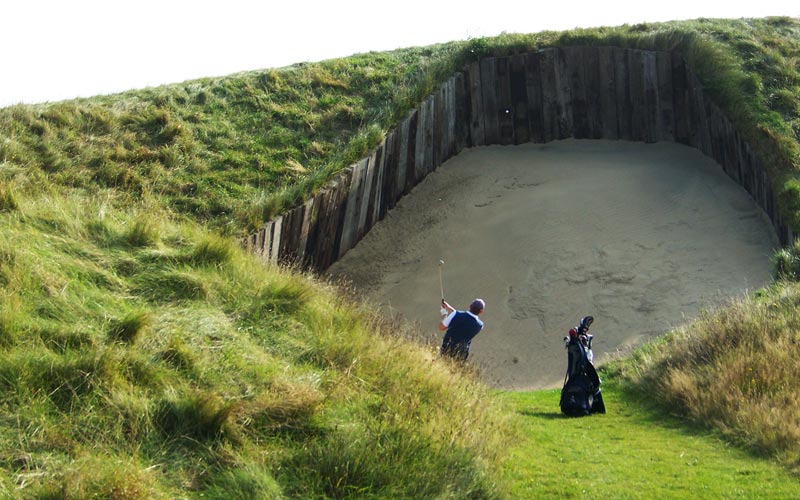
Pity the man who gets into Big Bertha off the fourth tee.
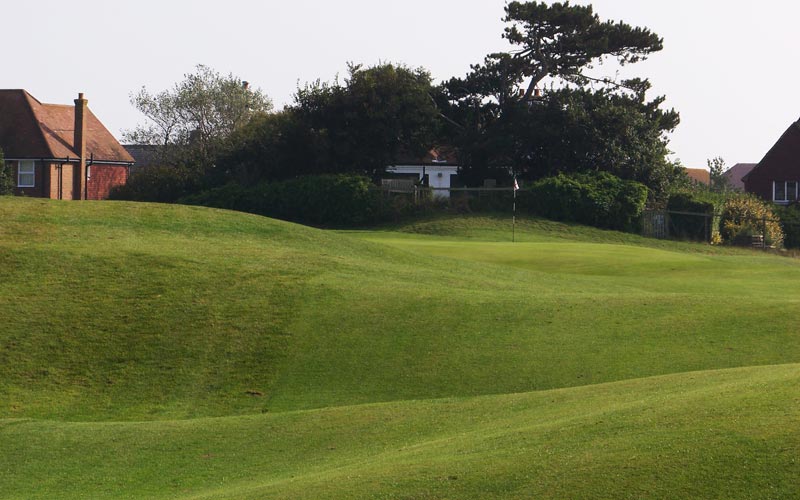
From an uneven lie, a long uphill approach is demanded to a…
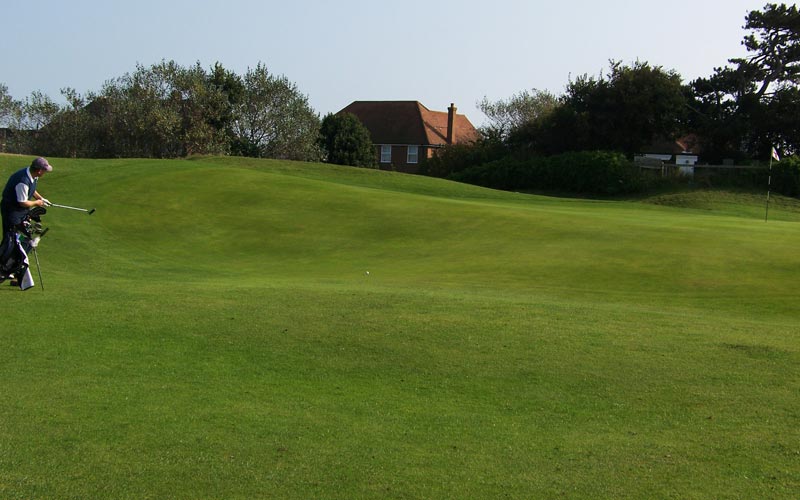
…rollicking green with a dramatic four foot false front. Both demanding and fun, this hole captures why links golf reigns supreme over all other forms.
Fifth hole, 420 yards; This hole and the next were par threes under Laidlaw Purves‘s initial routing. One reason is that the dune line down the left ran all the way to the property’s edge. Laidlaw Purves didn’t have the inclination, the equipment or the budget to alter the dun escape. However, all that changed within twenty-five years from the course’s opening. A gap was knocked into the dune some three hundred yards from the tee and a new, bunkerless green was built on the dune’s other (left) side. Thus, today’s striking par four was born.

A draw at the dune at the end of the fairway is ideal as it leaves the golfer with…
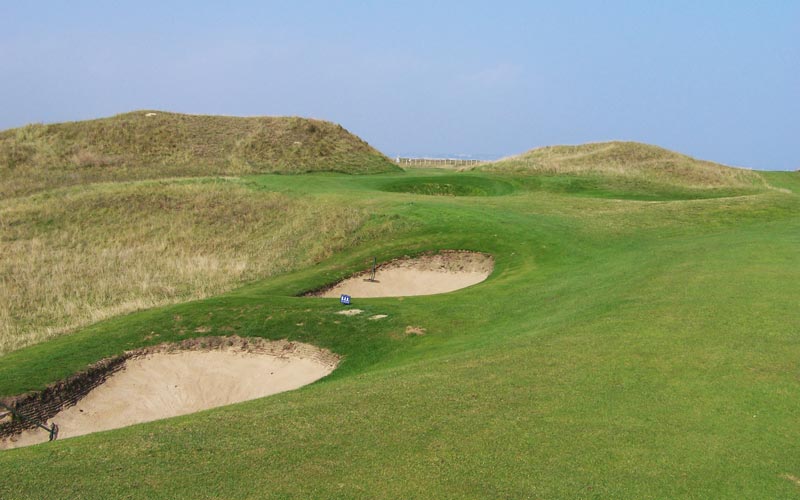
…this view of the fifth green through the gap in the dunes (the white flag is barely visible against the boundary fence).
Sixth hole, 170 yards; Curiously for a course with so many standout holes, the most famous one at Royal St. George‘s hasn’t existed for over seventy years! Laidlaw Purves first built The Maiden as a blind par three played over the top of the tallest dune on the property. Essentially, it played at a right angle to the hole of today (i.e. the tee was near the bunkers in the photograph above of the fifth hole). When St. George’s first opened, it was enormously difficult, given the number of blind shots combined with Laidlaw Purves‘s love of cross hazards. Case in point: the winning score for the 1894 Open was 326 (!). The change in the fifth hole from a par three to par four was done in conjunction with the desire to move this tee to the other side of the dune and build a more conventional par three. The sixth is still called the Maiden and it’s a fine hole, though not one of the best on the course.
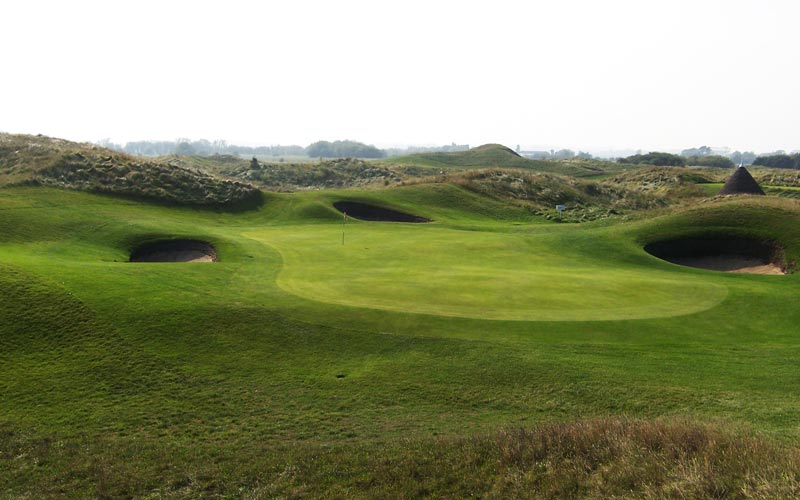
The Maiden’s green has always been here at the base of the dune. However, its tee has moved at least three times, with each move making the hole less terrifying.
Seventh hole, 530 yards; The land upon which the front nine is routed over is wild and tumbling; no wonder Laidlaw Purves settled upon it for building his ideal golf course. It would be nonsensical not to have at least one or two blind tee shots as otherwise, the holes simply would not be reflective of the land upon which they are on.Thus, traditionalists, more so than golfers with the card and pencil mentality, delight at the sight of the skyline fairway at the seventh. Though it has been massaged over the decades,the dune escape over which the fairway falls still presents the classic uncertainty of a blind tee ball.

The tee shot at the seventh: blind and excellent in all respects.
Royal St. George’s Golf Club
England
Eighth hole, 455 yards; Pennink’s second major change in 1975 was to convert the eighth from a par three to a formidable par four. Rather than walking to the left of the seventh green after holing out, golfers now walk straight ahead to the eighth tee along the property line. The tee ball finds one of the more level fairways on the course but the second shot is the real highlight as it is played down across broken ground to a green surrounded by dunes. The former eighth known as Hades was a searching par thee but Pennink’s addition is a most handsome one.
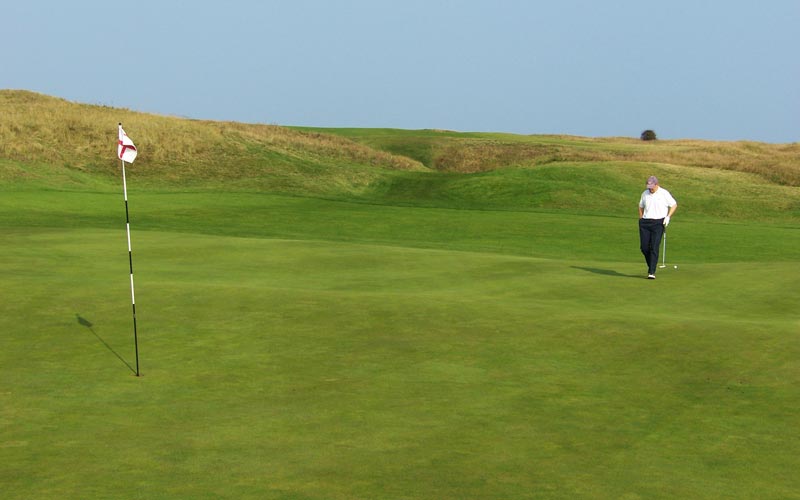
The view back up the eighth shows the broken ground that bisects the fairway and the green. As at the third, Pennink set a two tiered green in amongst the dunes.
Ninth hole, 385 yards; Once played closer to the tenth fairway, the ninth’s playing corridor was shifted to the left prior to the 1911 Open and its green was moved back forty yards, helping to reduce the disparity in length between the two nines.The random landforms throughout the hole help make it an absolutely charming drive and pitch hole. Though the course undoubtedly requires big hitting, holes like the ninth, tenth, and twelfth add a great deal of variety to its overall challenge.

The ninth fairway is a thing of beauty as it bobs and weaves through the dunes.
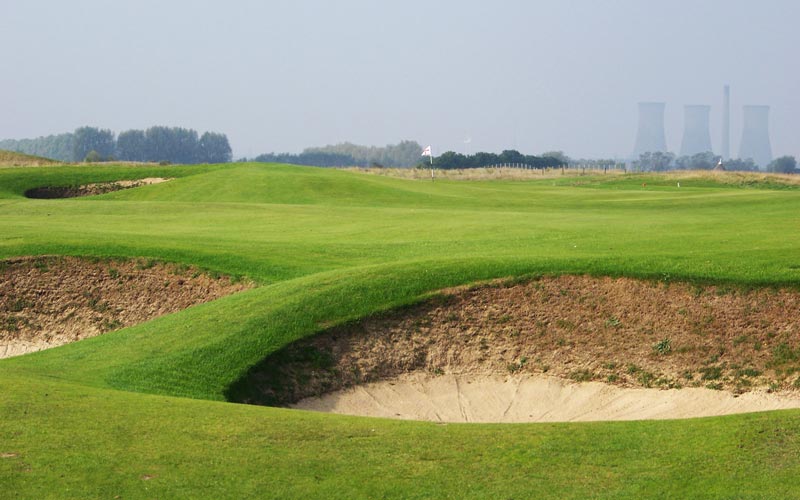
An ideal tee shot leaves this approach of ~100 yards into the cleverly contoured ninth green.
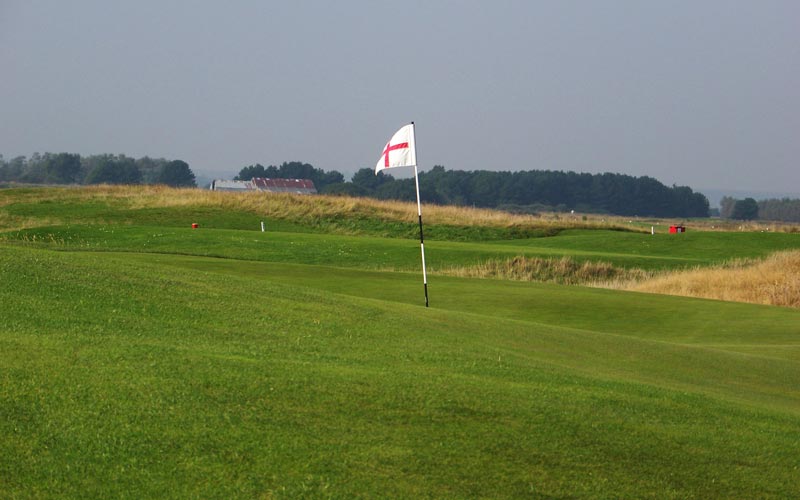
The ninth green is angled to the left behind this knob, which sends plenty of approach shots skittering across the green and down its tightly mown right bank.
Tenth hole,410 yards; Though the tenth has been stretched some in recent years, the ninth and tenth still represent short par fours of uncommon character. Similar to the seventh and eighth at Sand Hills Golf Club, the two play parallel to each other and run in opposite directions, meaning that the wind can make the holes play wildly different, despite their similar length.In the case of the tenth, its plateau green is the high spot on the back nine and is universally considered one of the game’s great skyline greens. Ian Fleming made the hole famous when he described it in James Bond’s match in Goldfinger as the most dangerous par four in England. Tom Kite would agree as this hole ruined his 1985 Open bid as he clumsily went from side to side.
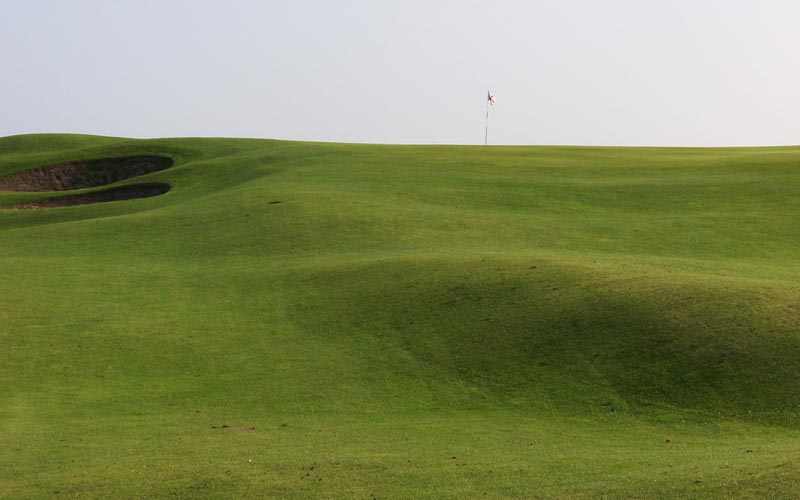
The skyline green at the tenth: though feared, note its clean, uncluttered lines.
Eleventh hole, 240 yards; Here is the third and final of Pennink’s major changes. For its first eighty-five years, this was a well regarded drive and pitch hole. However,with Pennink’s change of the eighth from a par three to a par four, the course only had three par threes. Indeed, there was a gap from the sixth to sixteenth without one. Furthermore, the sixth and sixteenth holes play in the same general direction away from Pegwell Bay, an undesirable trait for a windy site.A final consideration was that the back was still significantly longer than the front. Pennink addressed all these issues when he turned the eleventh in to the par three that it is today. Nick Faldo sent the British crowd into hysteria when his tee ball in the fourth round of the epic 1993 Open clanged off the flag, stopping inches away.
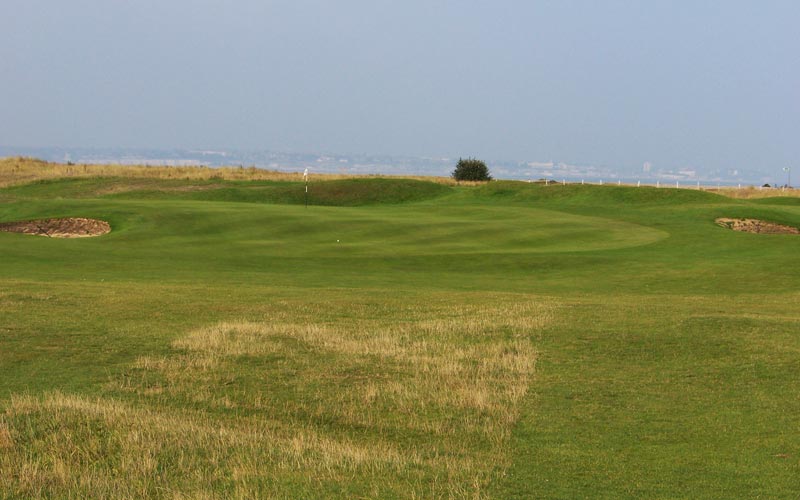
Pennink’s eleventh green has several appealing Redan playing characteristics: an angled green from front right to back left, a high bank right to work the ball off, and a bunker front left.
Twelfth hole, 380 yards; Royal St. George’s is a big course with lots of interesting playing angles. Some of the best are at the twelfth and thirteenth where an eight foot high dune line that parallels the coast was put to particularly good use.The tee boxes of both holes are set on diagonal lines to the dune line and the golfer is free to make up his own mind as to what the day’s correct line is from each tee. The temptation to be too greedy and cut off too much off these tees needs to be resisted. The sight of the twelfth flag from the tee makes it particularly difficult to make yourself aim well to its left. Courses with fixed, pre-determined playing lines such as tightly wooded parkland courses are infinitely less interesting than courses like Royal St. George’s where the golfer has options to mull over.
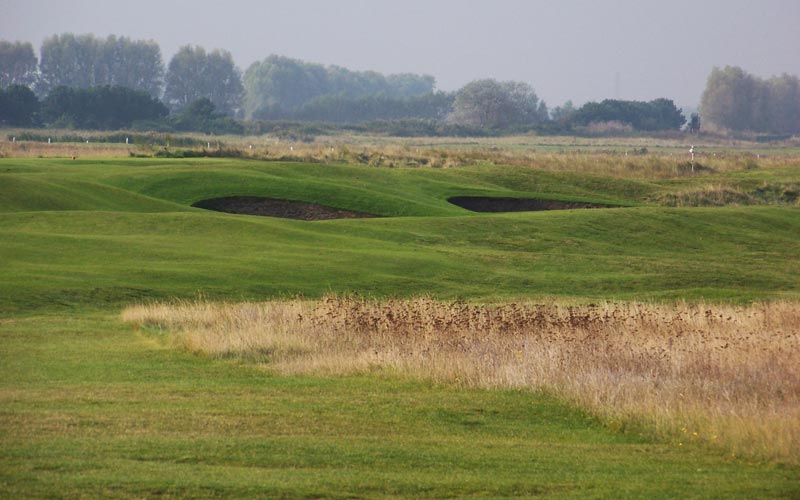
The golfer needs to resist being pulled too far to the right off the tee by the allure of the white flag on the twelfth green.
Thirteenth hole, 460 yards; A spine runs the length of the thirteenth green with the green’s left half nearly two feet higher than its right half. The hole, and especially the green, has many admirers, including Ben Crenshaw who views it as one of the best greens anywhere. Furthermore, he told the author that, with the exception of The Old Course at St. Andrews, ‘I believe that Royal St. George’s has the finest set of greens of any of the Open courses. The variety found throughout all its greens really is of exception.’
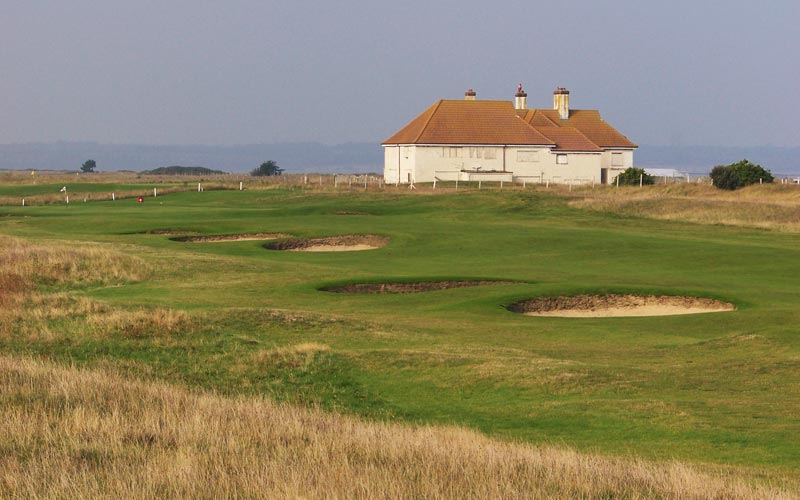
The inside of the thirteenth hole is well defended, forcing the golfer to play out to the right. The abandoned building is the old Prince’s clubhouse.
Fourteenth hole, 550 yards; Out of bounds hard down the entire right makes the fourteenth nerve wrecking, especially given the expansiveness of the preceding thirteen holes. Now all of a sudden,one steps to the tee, knowing anything pushed right will require another shot to be played from the same spot. Much to his credit, Greg Norman hit the perfect boring drive in the fourth round in 1993 after watching his fellow competitor Bernard Langer cut it over the boundary fence moments earlier. When Purves first laid out this three shotter, the Suez Canal that crosses the fairway was quite difficult to carry in two with hickories and a gutta-percha ball. In today’s modern game, the tiger golfer is more worried about the canal off the tee. In 2004, the green was moved back forty-three yards and two bunkers were added in the fairway sixty yards from the green, in line with the left edge of the green. Thus, the confident golfer that plays down the hole’s right enjoys clear access to the green. The more timid play is down the left but eventually, the golfer must play back toward the green – and the out of bounds.
Fifteenth hole, 475 yards; The fifteenth is another hole that has been lengthened over the years without changing or undermining the original integrity.The tees were recently pushed thirty-five yards,insuring that golfers still need to hit long or middle irons into the green, which is elevated four feet above the fairway and shrugs off all but the well struck shot. Tom Simpson was a great admirer of this hole.
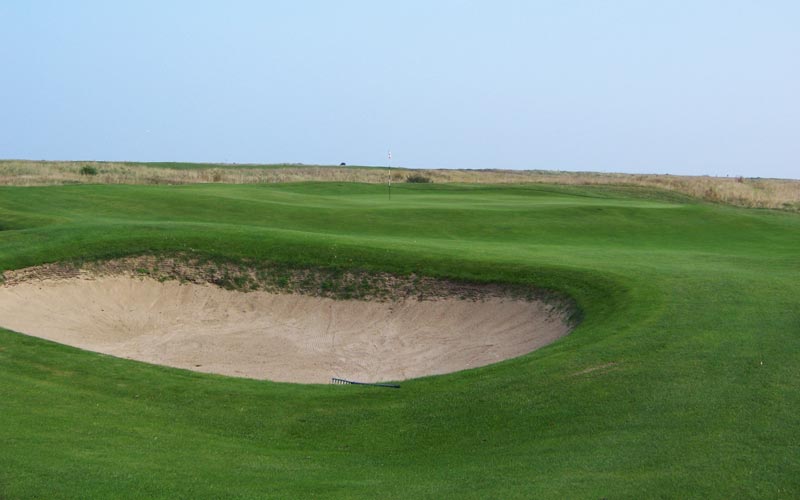
The none-too-big fifteenth green is a fiddly one to hit, especially in a cross breeze.
Sixteenth hole, 160 yards; Though surrounded by eight deep bunkers, mercifully the putting surface is relatively large for a hole of this length. The rub comes when the club places the hole locations around the perimeter of the green, tempting the golfer to get a bit more greedy than just playing safely to the middle. The merits of the sixteenth were showcased in 2003 Open when Thomas Bjorn chased after a right hole location, only to see his tee ball come to rest in the right green side bunker. His first bunker shot climb onto the putting surface but its shoulder returned the ball back to his feet. The same sad event occurred again and after Bjorn holed out for a five, the Open Championship was lost.
Seventeenth hole, 425 yards; Though the front nine has the bigger dunes, the penultimate hole lays claim to perhaps the most convoluted fairway with beautiful random land forms throughout. Importantly, in such situations, plenty of fairway width needs to be maintained; otherwise, it becomes too much hit and hope with balls caroming into the rough with monotonous regularity. The club is aware that the fairway was too narrow for the 2003 Open with less than thirty percent of the field holding it; look for a better presented hole (i.e. the fairway will be wider, especially to the right)in 2011 when the Open returns.Amusingly, in 1990, the author was playing Royal St. George’s as the final course of a ten course swing through England. The match and the trip were all square on the seventeenth tee, or the 179th hole of the trip. Into the wind, a low running two iron was holed for a most unlikely eagle, proving to be the telling blow. When asked by the friendly professional inside how we had fared, we mentioned a highlight being the eagle on seventeen. The professional stared through his window at the flapping flags, and remarked, ‘Yes, in this wind, a two is a good score there today.’
Eighteenth hole, 460 yards; An underrated finishing hole, the eighteenth fairway is made by a pronounced hump found where tee balls like to land. A final string of Purves cross bunkers bisect the fairway 120yards from the green, which is made by a mean pit bunker front-right and Duncan’s Hollow on the left.
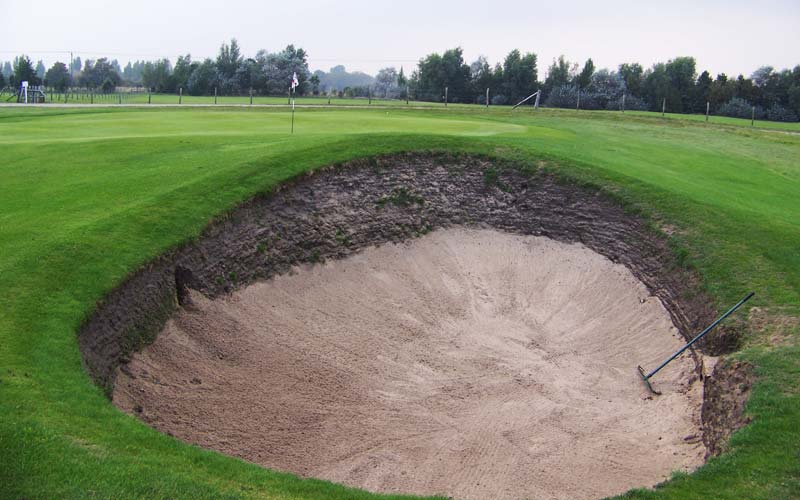
The abrupt vertical wall of the Home green’s right front bunker is visible from well back in the fairway, making golfers aim left and inadvertently toward a depression on the green’s middle left side.
Having hosted thirteen Open Championships over a 110 year period, as well as twelve Amateur Championships, two Walker Cups and one Curtis Cup, Royal St. George’s has time and again proven that it represents the ultimate in links golf in particular and in the game of golf in general.With its equal measures of challenge (e.g., the stern two-shotters on the run home from the thirteenth) and charm (e.g., the first nine),Sandwich is the rare links that is both a championship course and a thrilling lay-out for member play.Better than nearly any other course, it proves that championship golf need not be dull and unimaginative and that fun golf need not be easy; rather, there is an attainable ideal that compromises neither set of values.Change has been needed throughout its illustrious past, yet such change occurred without sacrificing the original overall intent of the course.If Darwin were to see today’s course, he would recognize it and, the author believes, his critical eye would approve of how the course’s evolution has it remaining as the United Kingdom’s supreme test south of St. Andrews.
The End



![Minchinhampton (Old) [2016]](https://golfclubatlas.com/wp-content/uploads/2018/09/Minchinhampton-500x383.jpg)
![St. Enodoc (Church) [2017]](https://golfclubatlas.com/wp-content/uploads/2017/11/St.-Enodoc-500x383.jpg)
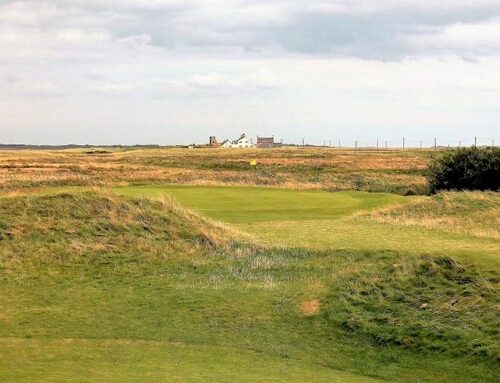
![Sunningdale (Old) [2014]](https://golfclubatlas.com/wp-content/uploads/2017/11/Sunningdale-Old-Course-500x383.jpg)
